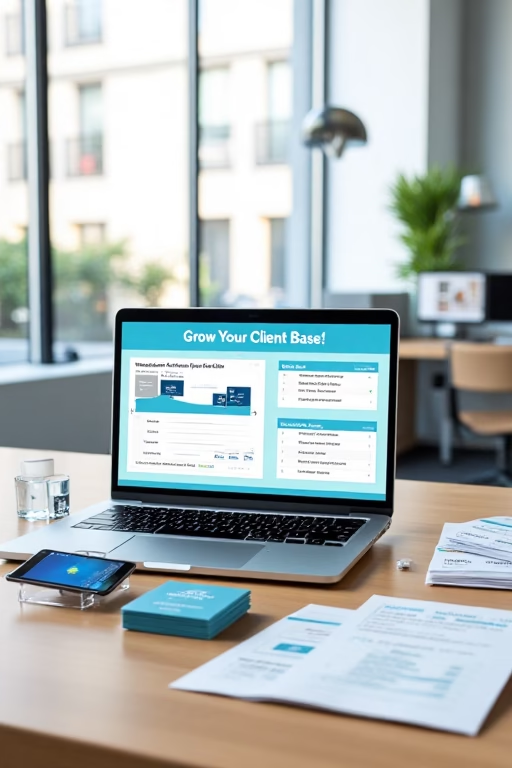How to Sell More Accounting & Bookkeeping Services: Getting More Clients
Your Growth Blueprint by Market Wiz
Table of Contents
- Introduction: Why Clients Matter
- 1. Defining Your Niche & Positioning
- 2. Packaging & Pricing Your Services
- 3. Lead Generation Strategies
- 3.1 Referral Programs
- 3.2 Networking & Events
- 3.3 Content Marketing
- 4. Digital Outreach & Automation
- 5. Consultative Sales Process
- 6. Client Onboarding & Retention
- 7. Leveraging Tech & Tools
- 8. Analytics & Continuous Improvement
- Conclusion & Next Steps
- 25 FAQs
- 25 Extra Keywords
Introduction: Why Clients Matter
In accounting and bookkeeping, each new client amplifies revenue and referrals. But attracting quality clients—those who value your expertise and remain long-term partners—requires more than a basic pitch. You need strategic positioning, targeted marketing, and a seamless sales journey to stand out in a crowded market.
This guide by Market Wiz delivers an end-to-end blueprint: from niching your services to deploying automation tools, nurturing leads, and ensuring clients stay through exceptional service.
1. Defining Your Niche & Positioning
Generalist accountants often compete on price. Instead, specialize—whether it’s startups, e‑commerce entrepreneurs, or medical practices. Research market needs, align with your strengths, and articulate a clear value proposition: “I streamline cash flow for growing e‑commerce brands.” A strong niche attracts high‑value clients and filters out tire-kickers.
2. Packaging & Pricing Your Services
Create tiered service bundles—Basic (monthly bookkeeping), Pro (financial reporting & advisory), Premium (CFO services & tax planning). Each package should outline deliverables, frequency, and clear outcomes. Use value-based pricing to align fees with client ROI, not merely hours spent.
3. Lead Generation Strategies
3.1 Referral Programs
Leverage existing satisfied clients by offering referral incentives: discounts or complimentary services. A structured referral program transforms happy clients into active advocates.
3.2 Networking & Events
Attend industry meetups and host lunch-and-learn sessions. Position yourself as an expert speaker on tax changes or cash‑flow management to connect with decision‑makers.
3.3 Content Marketing
Publish blog posts and whitepapers—“Top 5 Tax Deductions for Freelancers”—to capture organic search traffic. Gate premium guides behind an email signup to grow your list.
4. Digital Outreach & Automation
Use LinkedIn to share client success stories and tax tips. Run targeted ads to business owners in your niche. Implement email drip campaigns to nurture leads—automatically sending relevant insights and invitations to strategy calls.
5. Consultative Sales Process
High‑value clients want partners, not order-takers. Conduct discovery calls to understand their pain points—cash‑flow woes, audit fears—and propose tailored solutions. Use case studies and data to build credibility and handle objections proactively.
6. Client Onboarding & Retention
Deliver a smooth onboarding: digital welcome packets, clear timelines, and kickoff meetings. Provide a client portal for document exchange. Schedule quarterly business reviews to demonstrate progress and uncover upsell opportunities.
7. Leveraging Tech & Tools
- Use cloud accounting platforms (QuickBooks Online, Xero) for real‑time collaboration.
- Automate routine workflows with Zapier integrations—invoice reminders, data entry.
- Implement client portals for secure document sharing and communication.
8. Analytics & Continuous Improvement
- Track lead sources and conversion rates in your CRM.
- Monitor client satisfaction via NPS surveys.
- Review service package performance quarterly—refine based on feedback and profitability.
Conclusion & Next Steps
Growing your accounting and bookkeeping client base hinges on clear positioning, strategic lead generation, and a consultative approach. Start by defining your niche, creating irresistible service bundles, and launching a targeted outreach campaign this month. With consistent execution and client-centric service, you’ll see your practice thrive.
25 Frequently Asked Questions
1. How do I choose my niche?
Assess industries you know well, market demand, and competition to find a profitable gap.
2. What should my basic package include?
Monthly bookkeeping, bank reconciliations, and basic financial statements.
3. How do I price my services?
Combine value-based pricing with tiered packages to reflect client ROI and complexity.
4. How can I get referrals?
Ask satisfied clients and offer incentives like service credits or discounts.
5. Is LinkedIn advertising effective?
Yes—for targeting business owners and finance decision-makers in specific industries.
6. How often should I blog?
Monthly posts optimized for long-tail keywords can drive consistent traffic.
7. What CRM should I use?
HubSpot or Zoho CRM work well for small firms, offering lead tracking and automation.
8. How do I handle objections?
Prepare case studies showing past savings and use discovery calls to address specific concerns.
9. Should I offer free consultations?
Yes—use them to qualify leads and demonstrate expertise without commitments.
10. How do I onboard clients?
Provide digital welcome packets, set expectations, and schedule an introductory meeting.
11. How to improve client retention?
Regular check-ins, transparent reporting, and proactive advice keep clients engaged.
12. What tech integrations help?
Zapier, client portals, and automated invoicing streamline workflows and reduce errors.
13. How to track marketing ROI?
Monitor lead source, cost per lead, and conversion rates in your CRM dashboard.
14. Should I host webinars?
Yes—topics like tax planning for startups attract leads and position you as an expert.
15. How many networking events per month?
Aim for 2–3 local events or virtual roundtables to build relationships consistently.
16. How to price tax services?
Flat fees based on complexity and volume, or hourly rates for specialized returns.
17. What’s the best email cadence?
Bi-weekly newsletters and monthly drip sequences nurture leads without overwhelming them.
18. How to upsell services?
Identify additional needs during reviews and propose relevant add-ons, like payroll or CFO advisory.
19. How to measure client satisfaction?
Use NPS surveys and follow-up calls to gather feedback and address issues.
20. What metrics matter most?
Client acquisition cost, lifetime value, churn rate, and average engagement size.
21. Should I publish case studies?
Absolutely—highlight measurable results to build credibility with prospects.
22. How to handle scope creep?
Include clear change-order processes and additional fee structures in your contracts.
23. How often to review packages?
Quarterly—ensure offerings match market demand and profitability goals.
24. What’s a good referral rate?
Target 10–20% of new clients coming from referrals to ensure growth and trust.
25. What’s the first step?
Define your ideal client persona and craft a clear value proposition to test in outreach.
25 Extra Keywords
- accounting niche marketing
- bookkeeping referral program
- CPA lead generation
- accounting service bundles
- value based pricing CPA
- LinkedIn ads for accountants
- bookkeeping automation tools
- client onboarding CPA
- accounting CRM integration
- tax planning webinars
- accounting content strategy
- accounting SEO tips
- email marketing for CPAs
- client retention bookkeeping
- accounting tech stack
- bookkeeping workflow optimization
- accounting case studies
- CPA networking events
- bookkeeping pricing models
- accounting NPS survey
- accounting upsell strategies
- accounting pilot projects
- accounting partnership marketing
- Market Wiz accounting guide
- bookkeeping KPI dashboard

















